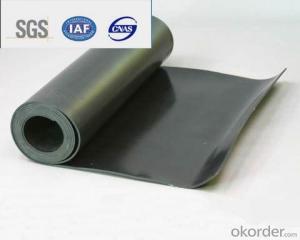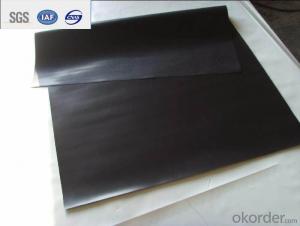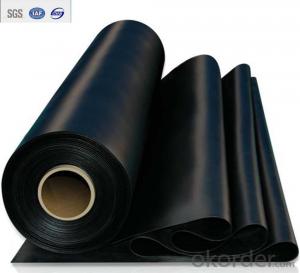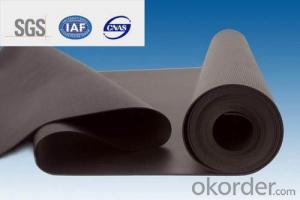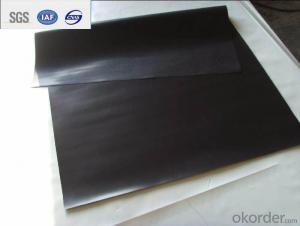EPDM Waterproofing Roofing Membrane with 1.2mm
- Loading Port:
- Qingdao
- Payment Terms:
- TT OR LC
- Min Order Qty:
- 2000 m²
- Supply Capability:
- 800000 m²/month
OKorder Service Pledge
OKorder Financial Service
You Might Also Like
Description Of EPDM Rubber Waterproof Membrane:
1. EPDM waterproof membrane is made from ternary ethylene-propylene rubber, which is for waterproofing of exposed and non-exposed applications.
2. EPDM waterproof membrane production adopts the world-advanced equipment of cold feeding extrusion and continuous vulcanization technology.
3. EPDM waterproof membrane is of high elasticity among high polymer waterproof materials and becomes a world-popular waterproofing material.
Main Features of EPDM Rubber Waterproof Membrane:
1. Excellent physical and mechanical performance
2. High tearing resistance
3. Good deformation adaptability
4. High puncture resistance
5. High aging resistance
6. UV resistance
Specifications of EPDM Rubber Waterproof Membrane:
Material | EPDM Rubber |
Size | 1.2m (width)*20m (length) or customized, weldable type 2.05m or 4m width |
Thick | 1.2mm, 1.5mm, 2.0mm |
Type | Vulcanized & Weldable |
Pattern | Non-reinforced (homogeneous) |
Certificate | ISO9001/14001 |
Applications of EPDM Rubber Waterproof Membrane:
1.Roofs, Basement, Toilets
2. Industrial and civil building waterproofing
3. Geosynthetic liner for swimming pool, channels, irrigation system
4. Especially suitable for projects with high requirements in durability, anti-corrosion and deformation.
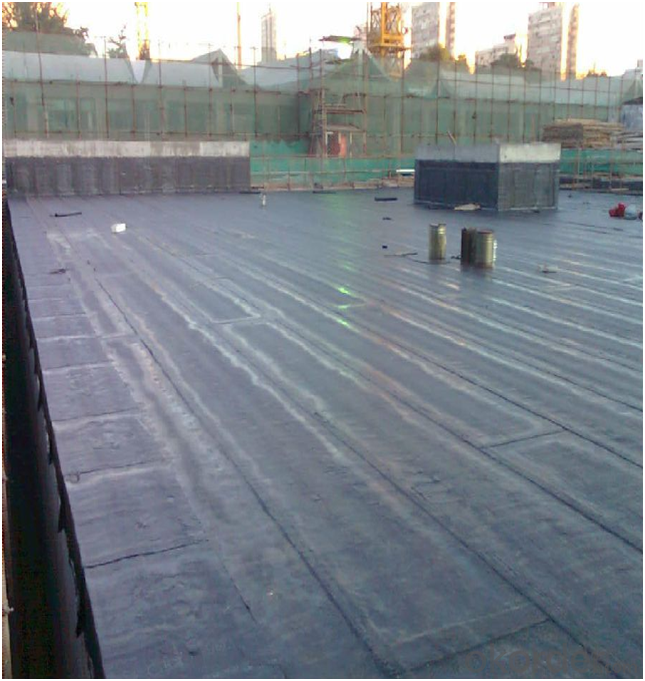


FAQ:
1. What are we supplying?
We are specialized in producing Colorful Asphalt Roof Shingle, SBS/APP modified bitumen waterproof membrane, Self adhesive bitumen waterproof membrane, PVC waterproofing membrane, EPDM rubber roofing membrane, Single Component Polyurethane Waterproof Coating, and Spray Polyurea Waterproof Coating.
2. How Many years experience do we have?
We have been exported to more than 20 countries in the past 15 years.
3. How long do we usually reply your request?
We always reply our customer within 24 hours.
- Q:Is the waterproofing membrane an insulating material?
- 2, with a metal foil surface modified asphalt waterproofing membrane, in order to expose the use of extended durability period, the surface of the composite layer of metal foil.
- Q:Can a waterproofing membrane be installed under tile or other flooring materials?
- Installing a waterproofing membrane is possible under various flooring materials, including tile. Typically used in areas prone to moisture, like bathrooms, kitchens, and basements, these membranes serve as a protective barrier. Their purpose is to prevent water from seeping through the floor and causing harm to the underlying structure. Usually, they are applied directly onto the substrate before the tile or flooring material is installed. This guarantees that any water or moisture that manages to infiltrate the flooring is redirected and prevented from reaching the subfloor. By utilizing a waterproofing membrane, you can safeguard your floors, extend their lifespan, and create a dry, moisture-free environment.
- Q:Can a waterproofing membrane enhance the durability or lifespan of a structure?
- Certainly, the durability and lifespan of a structure can be significantly enhanced with the use of a waterproofing membrane. This type of membrane acts as a protective layer, applied to the exterior of structures like buildings or bridges, with the purpose of preventing water penetration. Essentially, it functions as a barrier that stops water from seeping into the structure and causing harm. Water is a common and destructive element that can negatively impact the longevity of any structure. When water infiltrates a building or any other type of structure, it can lead to a variety of problems, including mold growth, deterioration of building materials, corrosion of metal reinforcements, and even structural instability. However, by implementing a waterproofing membrane, these risks can be significantly reduced or even eliminated altogether. The installation of a waterproofing membrane not only prevents water from entering, but it also safeguards the structure against other environmental factors such as moisture, humidity, and freeze-thaw cycles. Acting as a shield, it ensures that the building materials remain intact and reduces the likelihood of cracks, leaks, and other forms of structural damage. By enhancing a structure's durability, a waterproofing membrane can effectively prolong its lifespan. Considered a long-term investment, it helps prevent costly repairs and maintenance caused by water-related issues. By keeping the structure dry and protected, it adds years or even decades to its lifespan, ultimately saving both time and money in the long run. In conclusion, a waterproofing membrane is an essential component for maintaining the durability and lifespan of any structure. By preventing water infiltration and protecting the building materials from damage, it ensures the longevity of the structure and provides peace of mind to its owners and occupants.
- Q:Can a waterproofing membrane be used on precast lead surfaces?
- Yes, a waterproofing membrane can be used on precast lead surfaces. The membrane provides an additional layer of protection against water penetration, helping to prevent leaks and moisture damage on the precast lead surfaces.
- Q:Can a waterproofing membrane be used on roofs with flat surfaces?
- Roofs with flat surfaces can indeed benefit from the application of a waterproofing membrane. In fact, it is quite common to use these membranes on flat roofs to safeguard against water infiltration. The primary function of these membranes is to establish a barrier that obstructs water from seeping into the roof structure and causing harm. Typically, they are constructed using materials like modified bitumen, EPDM, or PVC, which exhibit great resistance to both water and UV rays. To install the membrane, it can be done by torch-application, adhesive adherence, or mechanical fastening. To ensure optimal effectiveness and longevity of the waterproofing membrane on a flat roof, it is crucial to guarantee proper installation and regular maintenance.
- Q:Can a waterproofing membrane be installed on any surface?
- No, a waterproofing membrane cannot be installed on any surface. It requires a suitable and prepared surface that is clean, dry, and structurally sound for proper installation and effectiveness.
- Q:Can a waterproofing membrane be used for a garden pond liner?
- Certainly! A garden pond liner can be made using a waterproofing membrane. The primary purpose of a waterproofing membrane is to stop water from seeping through it, which makes it a great option for constructing a garden pond with a tight seal. By using a waterproofing membrane, leaks can be effectively prevented, guaranteeing that the water remains within the pond. Moreover, waterproofing membranes are generally long-lasting and can withstand UV rays, chemicals, and punctures, all of which are essential considerations when choosing a material for a pond liner. Nonetheless, it is vital to ensure that the selected waterproofing membrane is specifically designed for pond use and is safe for aquatic life.
- Q:Can a waterproofing membrane be used for sewage treatment plants and wastewater facilities?
- Yes, a waterproofing membrane can be used for sewage treatment plants and wastewater facilities. These membranes are designed to prevent water penetration and are commonly used to protect structures from water damage. In sewage treatment plants and wastewater facilities, where constant exposure to water and moisture is present, a waterproofing membrane can help maintain the integrity of the structures and prevent any leaks or water seepage.
- Q:Is a waterproofing membrane resistant to mold and mildew growth?
- Yes, a waterproofing membrane is typically resistant to mold and mildew growth. The membrane acts as a barrier against moisture, preventing it from seeping into the building materials and creating an environment for mold and mildew to thrive.
- Q:Does a waterproofing membrane require any maintenance or regular inspections?
- Yes, a waterproofing membrane does require maintenance and regular inspections. While waterproofing membranes are designed to be durable and long-lasting, they are not immune to wear and tear or potential damages. Regular inspections are essential to identify any signs of damage or deterioration, which can then be addressed promptly to prevent further issues. Maintenance activities may include cleaning the membrane to remove dirt or debris, repairing any visible cracks or tears, and ensuring proper drainage and water flow. Additionally, it is advisable to follow the manufacturer's guidelines for maintenance and schedule professional inspections periodically to ensure the effectiveness and longevity of the waterproofing membrane.
1. Manufacturer Overview |
|
|---|---|
| Location | |
| Year Established | |
| Annual Output Value | |
| Main Markets | |
| Company Certifications | |
2. Manufacturer Certificates |
|
|---|---|
| a) Certification Name | |
| Range | |
| Reference | |
| Validity Period | |
3. Manufacturer Capability |
|
|---|---|
| a)Trade Capacity | |
| Nearest Port | |
| Export Percentage | |
| No.of Employees in Trade Department | |
| Language Spoken: | |
| b)Factory Information | |
| Factory Size: | |
| No. of Production Lines | |
| Contract Manufacturing | |
| Product Price Range | |
Send your message to us
EPDM Waterproofing Roofing Membrane with 1.2mm
- Loading Port:
- Qingdao
- Payment Terms:
- TT OR LC
- Min Order Qty:
- 2000 m²
- Supply Capability:
- 800000 m²/month
OKorder Service Pledge
OKorder Financial Service
Similar products
New products
Hot products
Related keywords
